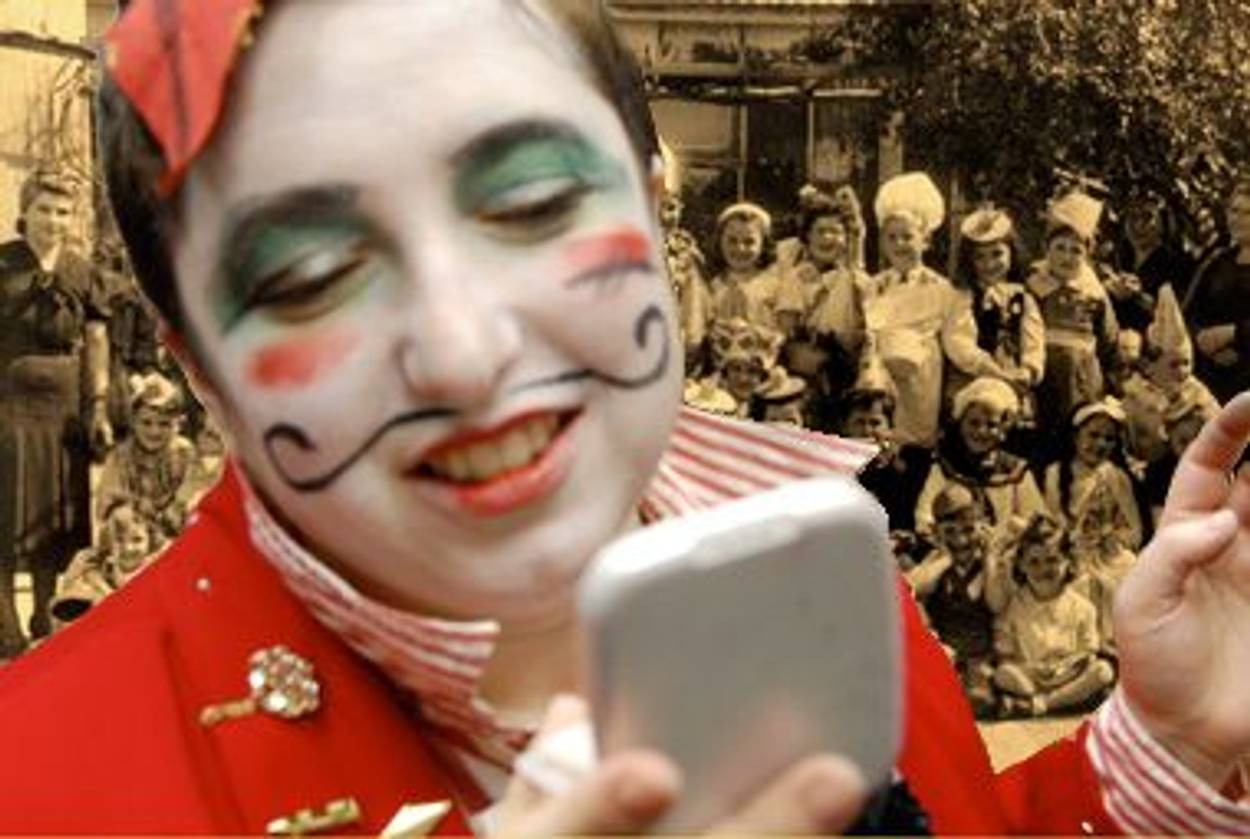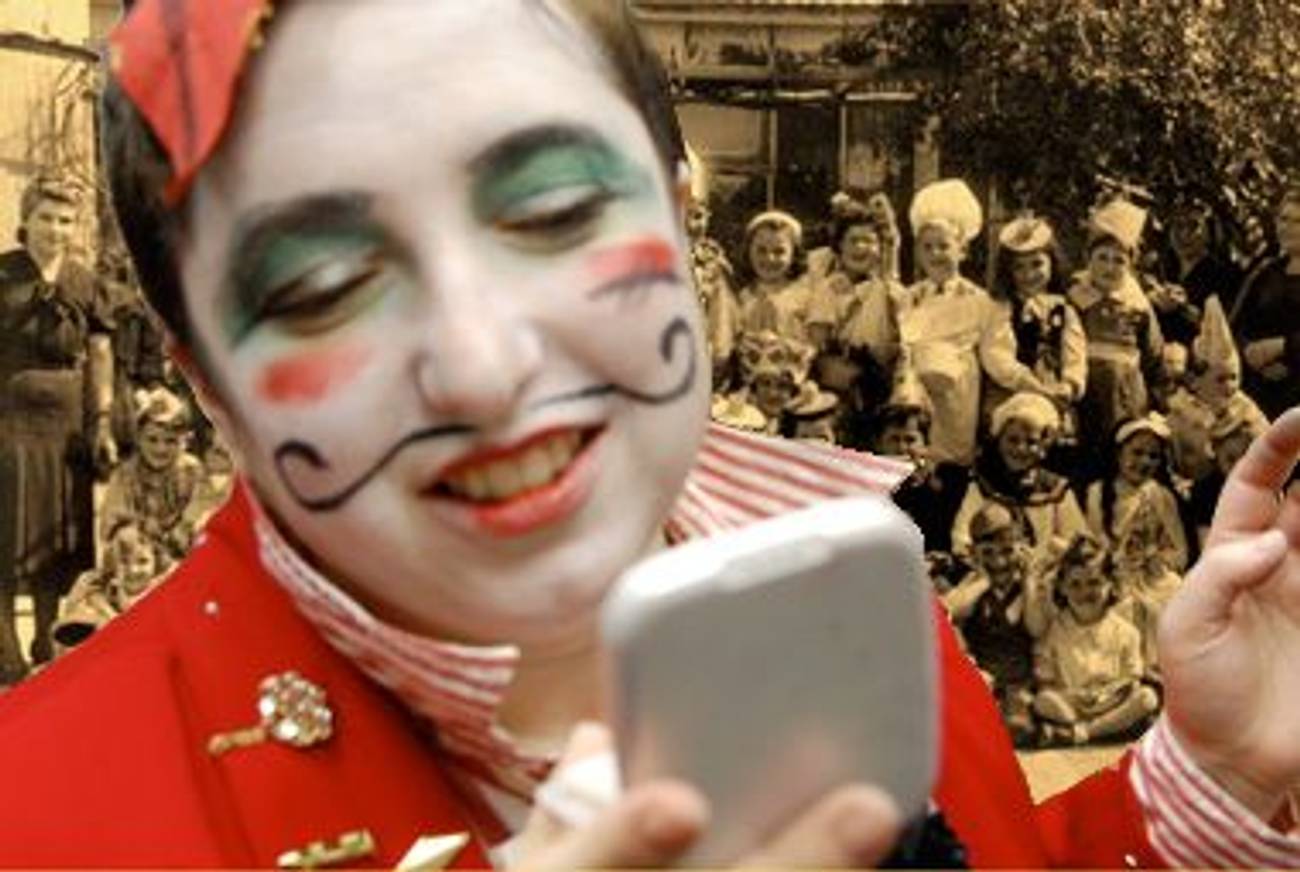Unmasked
Has Purim replaced Passover as the best holiday vehicle for expressing individual Jewish identity?




In the cosmology of Jewish holidays, Passover has traditionally been the celebration whose readings and rituals inspire worshippers to question the nature of their own Jewish values and beliefs. For decades, Jews of all persuasions have fashioned their own Seders, some adding a cup for the prophetess Miriam in celebration of Jewish women, others supplementing the Haggadah with a prayer for Darfur—all an affirmation of the celebrants’ core beliefs and of Hebrew heterodoxy.
In recent years, however, another holiday has started eclipsing Passover’s status as Jewish identity’s vastest playground. Sanctioning a host of transgressive behaviors—from drunkenness to masquerading in costume—and commemorating a tale of Jewish valor that culminates in the slaughter of 75,000 Persians more than 2,000 years ago, Purim is increasingly providing Jews of all backgrounds and ages with an opportunity to engage with whatever concerns them personally and politically.
In a way, this shouldn’t come as a surprise. The Book of Esther, Purim’s ur-text, is one of only two biblical books that omit any mention of God, focusing instead on individuals and the consequences of their actions. Purim is also a holiday traditionally observed not in the synagogue (Megillah readings aside) or even around the family table, but on the street and in nightclubs, surrounded by friends. Add to that the playful tradition of masquerading, and Purim comes as close as possible to that rarest bird, a Jewish holiday that transcends the communal and allow revelers to focus instead on the personal.
Emily Nepon, a writer, performer, and activist, has come to see Purim as an opportunity to reconcile her Jewish and queer identities. In 2004, she helped organize “Suck My Treyf Gender,” an evening of progressive-themed performances inspired by the Purimspiel, the ancient tradition of staging rowdy bits of theater loosely based on the holiday’s story.
“There was something incredibly powerful about the overlap of the Jewish cultural norms of Purim and the queer cultural otherness,” she said. “When we put them together, we were shocked by how much they magnified each other. We were moved by it.”
The evening came complete with a manifesto, which reflected these sentiments. “On Purim,” it reads, “we are religiously obligated to get so shit-faced [drunk] we can’t tell the difference between ‘blessed’ Haman, and ‘cursed’ Mordechai. Binaries, dichotomies, opposites are emphasized, exaggerated and celebrated. We masquerade as Good vs. Evil, Male vs. Female, Oppressed vs. Oppressor, but the goal is not to reinforce these dichotomies, but to realize that they are false separations, that there is a beautiful space in between all opposites, and that is the space where we live as happy, healthy beings. It is in between the extremes, somewhere between ‘male’ and ‘female,’ healing our experiences of oppression while checking ourselves on the power we have to oppress others, that we walk Hashem’s path.”
And with a new reading of the holiday rose new heroes. Mary Gendler suggests in her 1976 essay, “The Restoration of Vashti,” that we look at Vashti and Esther as two contrasting archetypes. The two women “serve as models of how to deal with [male] authority,” she writes. “And the message comes across loud and clear: women who are bold, direct, aggressive, and disobedient are not acceptable; the praiseworthy women are those who are unassuming, quietly persistent, and who gain their power through the love they inspire in men… We have only to look at the stereotyped Jewish Mother to attest to the still-pervasive influence of the Esther-behavior model.”
This popular feminist interpretation—Esther as subdued supplicant versus Vashti as brave resister of the patriarchy—endures and thrives, frequently serving fodder at Jewish educational institutions, including Bar Ilan University in Israel, hardly a bastion of progressivism.
Nepon embraces this interpretation. A few years ago, she wrote a Purimspiel in which Vashti becomes possessed by the spirit of Lilith, a mythical figure that Jewish tradition believes was Adam’s first wife, who was banished from the Garden of Eden after she refused to be subservient to her husband and eventually turned into a demon.
“I think that’s a pretty common feminist experience,” Nepon said of her play. “Being true to yourself can get you kicked out of the community, and if you do stick up for yourself and do your own thing you’re in danger of losing your community… Many people, not just radical weirdos, experience Vashti as a feminist. I think for many of us it’s easier to identify with that character than with the one who’s eventually a tool of men. Esther gets credit for doing hard and scary things, but she’s essentially doing what everybody else is telling her to do. She’s courageous, but she’s not resisting anything out of any personal agency.”
Such talk, Abby Wisse Schachter believes, is leading to the holiday’s demise. In a recent article in Commentary titled “The Problem with Purim,” Wisse Schachter accused those invested in reimagining Purim with sacrificing the holiday’s traditional core on the altar of political correctness.
“For three decades,” she writes, “an effort has been underway to change not so much the observance of the holiday but the meaning of Purim itself. This celebration of a great reversal of fortune—the deliverance of the Jews of Persia from a massacre—has been transmogrified into a feminist holiday that also calls into question the entire concept of Jewish self-defense, which is at the heart of the story’s conclusion. Unfortunately, this effort to modernize the Purim story lionizes the wrong woman, promotes a false political message of nonviolence and tolerance, and worst of all embraces failure instead of promoting perhaps the greatest of Jewish heroines.”
The conservative point of view, then, is concerned with more than merely preserving the Purim of the past, it’s also about seeing Esther as an icon of Jewish self-defense. Esther’s successful appeal to allow the Jews to arm themselves against their foes, Wisse Schachter argues, may have led to bloodshed, but was also a good and necessary strategy, one that should inspire rather than repulse young Jews today.
But Wisse Schachter’s critique only further reveals how fertile a ground Purim has become for Jewish scholars seeking to explore the furthest reaches of Jewish history and thought. While gender and sexual orientation are possible prisms through which to observe the holiday, another, far more complex one is that of Jewish violence. Elliott Horowitz, a history professor at Bar Ilan, dedicated a book, Reckless Rites, to the history of Jewish violence and the inspiration it sometimes draws from the Purim story.
Baruch Goldstein is a gruesome case in point: In 1994, the Brooklyn-born resident of a settlement near Hebron walked into the town’s Tomb of the Patriarchs—sacred for both Muslims and Jews—opened fire, and murdered 29 Muslims. His timing was no coincidence. The massacre was carried out on Purim. Reached for comment shortly after news of the tragedy broke, Knesset member Hanan Porat of the National Religious Party giddily told reporters that since it was Purim, Jews were obligated to rejoice.
Goldstein’s bloody act, some scholars suggest, was one major catalyst in the drive to infuse Purim with personal and political meaning. Daniel Boyarin, a professor of Talmudic culture at the University of California, Berkeley, said that the massacre made many people pay serious attention to Purim’s intimations of Jewish violence.
“I think it was as much that event itself as anything else that led to changed perceptions,” he said. “I think that some of the things that Jews have done when they were oppressed in the Diaspora they’re still doing when they’re in control in Israel, and that’s inappropriate. When Jews spat at churches surreptitiously, that’s resistance. But when the Jewish majority of Israel treats Muslim cemeteries with contempt, that’s no longer resistance, that’s oppression. The same acts can take on different political meanings, given a change in political and social situations. We still have powerful enemies, there’s still real anti-Semitism, but that’s not the issue with respect to Israel’s Palestinian subjects, and we have to be very clear who Haman is as we celebrate Purim.”
The most prudent approach, Boyarin added, was not to allow the Purim pendulum to swing too far in any one direction, acknowledging the merits of both progressive and conservative interpretations of the holiday, but steering clear of any path that might lead worshippers where it had led Goldstein.
In a way, such shifts in meaning have always been Purim’s lot. Naomi Sheindel Seidman, a professor of Jewish culture at the Graduate Theological Union, noted that those Jews who’d integrated into European society in the 19th century rejected Purim as a crass celebration, while the following generation, comprised of many in the artistic avant-garde, embraced it warmly as a folk tradition that allowed for theatrical experimentation.
“What people were looking for,” she said, “were those parts of the tradition they felt could speak to them as moderns, and the Purimspiel fit the bill.”
It still does. Traditionally, the spiel has always invited participants—mostly unprofessional performers—to introduce various humorous and irreverent twists on the classic story. In that spirit, one recent New York Purimspiel featured puppets and protested the death penalty, another raised awareness to the issue of trafficking in women, a third used our current cultural fascination with zombies to tell a story about gentrification and displacement.
Such variety, said Nepon, was necessary if one was to successfully go about integrating Jewish life into the mosaic of modern life. “I found a way to locate my radical queer culture self in my Jewish life,” she said. “Purim is about chaos, about cross-dressing, about theater, about letting go. It’s an opportunity for everyone to try on being someone else, facing their biggest fears and their greatest hopes.”
Liel Leibovitz is editor-at-large for Tablet Magazine and a host of its weekly culture podcast Unorthodox and daily Talmud podcast Take One. He is the editor of Zionism: The Tablet Guide.